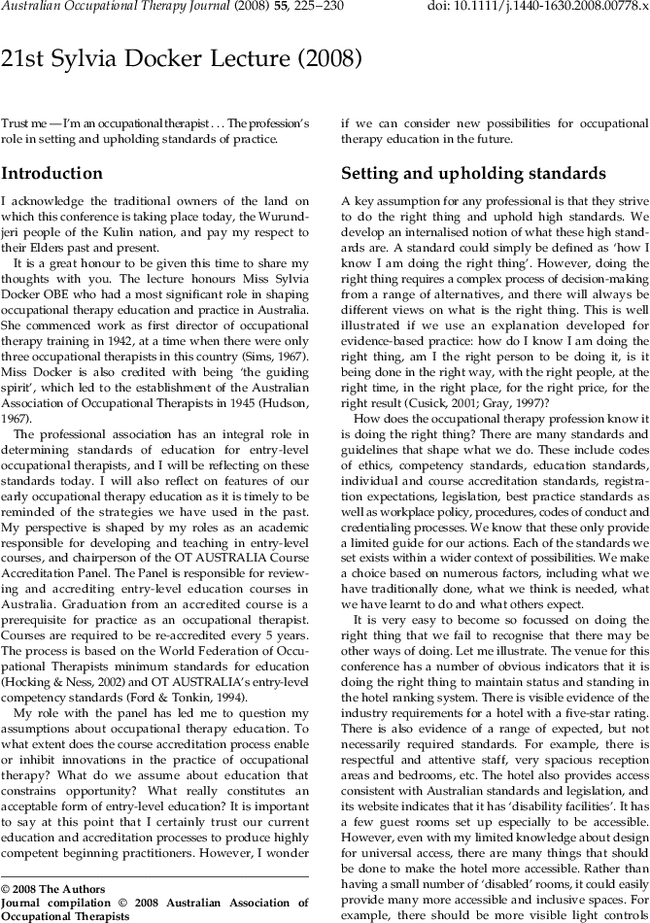21st Sylvia Docker Lecture (2008)
Rebecca Allen,
Rebecca Allen
Department of Occupational Therapy Faculty of Medicine, Nursing and Health Sciences Peninsula Campus Monash University Melbourne, Victoria 3199, Australia
Search for more papers by this authorRebecca Allen,
Rebecca Allen
Department of Occupational Therapy Faculty of Medicine, Nursing and Health Sciences Peninsula Campus Monash University Melbourne, Victoria 3199, Australia
Search for more papers by this author
References
- Anderson, B. & Bell, J. (1988). Occupational therapy. Its place in Australia's history. Sydney, NSW: NSW Association of Occupational Therapists.
-
Baptiste, S. (2005). Changing face of entry to occupational therapy practice: Some personal reflections from a Person Environment Occupation perspective.
Australian Journal of Occupational Therapy, 52, 179–180.
10.1111/j.1440-1630.2005.00512.x Google Scholar
- Canadian Association of Occupational Therapists ( CAOT) (2002). Enabling occupation: An occupational therapy perspective. Ottawa, ON: CAOT.
- China Disabled Persons Federation (2006). Communique on major statistics of the 2nd national sample survey on disability. Retrieved 29 August 2008, from http://www.cdpf.org.cn/old/english/top-7.htm.
- College of Occupational Therapists (2008). Occupational therapy careers handbook. Entry 2009/2010. Retrieved 1 September 2008, from http://www.cot.co.uk/public/otasacareer/handbook/2009-10.pdf.
- Commission on Social Determinants of Health (2007). A safer future: Global public health security in the 21st century. Geneva, Switzerland: World Health Organization.
- Commonwealth of Australia (2008). Australia 2020 Summit Final report. Canberra, ACT: Department of the Prime Minister and Cabinet. Retrieved 25 August 2008, from http://www.australia2020.gov.au.
- Coulthard, M. (2002). National perspective. Preparing occupational therapists for practice today and into the future. Canadian Journal of Occupational Therapy, 69, 253–260.
-
Cusick, A. (2001). OZ OT EBP 21C: Australian occupational therapy, evidence-based practice and the 21st century.
Australian Journal of Occupational Therapy, 48, 102–117.
10.1046/j.0045-0766.2001.00281.x Google Scholar
-
Douglas, F. (2000). An in-service part-time undergraduate programme for occupational therapy support workers.
Occupational Therapy International, 7, 206–212.
10.1002/oti.122 Google Scholar
- Duckett, S. (2005). Interventions to facilitate health workforce restructure. Australian and New Zealand Health Policy, 2, 14. Retrieved 15 May 2007, from http://www.anzhealthpolicy.com/content/2/1/14#B1.
- Duckett, S. (2008). The Australian healthcare system: Reform, repair or replace? Australian Health Review, 32(2), 322–329.
- Fleming, J. (2008). Health care workforce. In: S. Taylor, M. Foster & J. Fleming (Eds.). Health care practice in Australia. Policy, contexts and innovations (pp. 103–130). South Melbourne, Vic.: Oxford University Press.
- Ford, L. & Tonkin, J. (1994). Australian competency standards for entry-level occupational therapists. Fitzroy, Vic.: OT AUSTRALIA.
-
Fortune, T.,
Farnworth, L. &
McKinstry, C. (2006). Project-focussed fieldwork: Core business or fieldwork fillers?
Australian Occupational Therapy Journal, 53, 233–236.
10.1111/j.1440-1630.2006.00562.x Google Scholar
-
Gray, J. (1997). Evidence based health care: How to make policy and management decisions. Edinburgh, UK: Churchill Livingstone.
10.1016/S1462-9410(97)80004-6 Google Scholar
- Hocking, C. & Ness, N. (2002). Revised minimum standards for the education of occupational therapists. Forrestfield, WA: World Federation of Occupational Therapists.
-
Hudson, E. (1967). Introduction to the first Sylvia Docker lecturer.
Australian Occupational Therapy Journal, 14, 27–28.
10.1111/j.1440-1630.1967.tb00192.x Google Scholar
- Leggatt, S. (2007). Health professional education: Perpetuating obsolescence? Australian Health Review, 31, 325–326.
- McKinstry, C. (2005). From graduate to practitioner: Rethinking organisational support and professional development. In: G. Whiteford & V. Wright-St Clair (Eds.). Occupation and practice in context (pp. 129–142). Marrickville, NSW: Elsevier.
- Pattison, M. (2007). The occupational therapy ‘landscape of the future’: The results from the focus day at the 27th Council meeting of the World Federation of Occupational Therapists. WFOT Bulletin, 56(November), 5–10.
- Productivity Commission (2005). Australia's health workforce. Research report. Canberra, ACT: Commonwealth of Australia.
- Shah, C., Long, M. & Windle, J. (2007). Recognition of skills and qualifications: Labour mobility and trade in services. Melbourne, Vic.: Monash University Centre for the Economics of Education and training. Retrieved 31 August 2008, from http://www.education.monash.edu/centres/ceet/docs/otherpapers/mutualrecognition28aug2007.pdf.
-
Sims, G. (1967). Sylvia Docker lecture: Occupational therapy in Australia – the formative years.
Australian Occupational Therapy Journal, 14, 29–44.
10.1111/j.1440-1630.1967.tb00193.x Google Scholar
- Sinclair, K. (2006). Global competencies. In: ENOTHE's contribution to the World Congress of Occupational Therapy, Sydney, Australia, July, 2006. ENOTHE. Retrieved 2 September 2008, from http://www.enothe.hva.nl/new/enothe_wfot_contribution.pdf.
- State and Territory Health Ministers (2007). Caring for our health? A report card on the Australian government's performance on healthcare. Governments of the Australian Capital Territory, New South Wales, Northern Territory, Queensland, South Australia, Tasmania, Victoria and Western Australia. Retrieved 29 June 2008, from http://www.health.qld.gov.au/news/caringforourhealth/hlth_report2007.pdf.
-
Thibeault, R. (2006). Globalisation, universities and the future world of occupational therapy: Dispatches for the majority world.
Australian Journal of Occupational Therapy, 53, 159–165.
10.1111/j.1440-1630.2006.00608.x Google Scholar
- Townsend, E. & Polatajko, H. (2007). Enabling occupation II: Advancing an occupational therapy vision for health, well-being and justice through occupation. Ottawa, ON: Canadian Association of Occupational Therapists.
- Van Bruggen, H. (2001). European network of occupational therapy in higher education: A five year review. Occupational Therapy International, 8, 132–138.
-
Wilcock, A. (1999a). Reflections on doing being becoming.
Australian Occupational Therapy Journal, 46, 1–11.
10.1046/j.1440-1630.1999.00174.x Google Scholar
-
Wilcock, A. (1999b). Creating self and shaping the world.
Australian Occupational Therapy Journal, 46, 77–88.
10.1046/j.1440-1630.1999.00189.x Google Scholar
- World Health Organization (WHO) (2006). World Health Report 2006: working together for health. Geneva, Switzerland: WHO.




